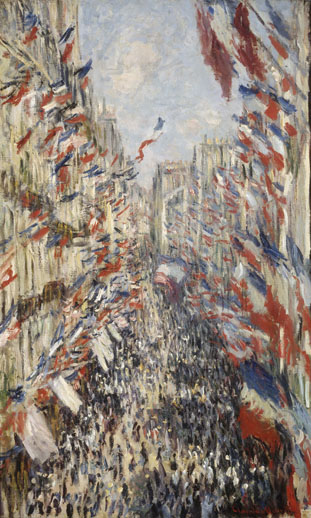Fr : version française / En: english version
The resilient Republic!
The cementing of the Third Republic, after eight years of sweeping depression (defeat in 1870, the Paris Commune and its crushing, second-rate quarrels between Orleanists and Legitimists), brought hundreds of thousands of Parisians onto the streets to mark the close of the 1878 Universal Exhibition.
The tricolor flag—highly symbolic after the ridiculous controversy raised by the monarchists—could be seen throughout the capital. The streets were filled with people dancing, singing and marching around the clock: France had awoken to a new Republic!
Republican reveling supplants religious processions
Canon fire woke me at daybreak, content to disturb the sleep of folk, whatever their views, on the pretext of celebrating freedom. Children replied to the official artillery by setting off fireworks in the street. It was time to get up.
I went outside. The city was already jubilant. Middle-class residents came to their doors and eyed the flags with a happy look on their faces. People laughed: the festivities were finally under way!
The people had indeed begun their party, though I doubt they knew why. They had been told there would be festivities, and that was enough. The people were happy and joyful. Their reveling would continue on into the evening, by order of the government, and tomorrow it would be over [...].
I strolled through the streets until I could bear the public display of jubilation no longer. Choirs bellowed, fireworks crackled, the crowd shook and shouted. Every outbreak of laughter expressed the same silly satisfaction.
By chance, I found myself in front of a church I had seen from afar the previous day, with its two towers. I went inside. The place was empty, cavernous, cold and lifeless. The tabernacle lamp shone like a speck of gold from the back of the dark choir. I took a seat in this chilly haven.
Outside, I could hear the explosions of rockets and the clamoring of the masses, so far away they seemed to come from another planet. I took to studying a huge stained window through which a thick, purple daylight poured into the sleepy temple. It also showed a people, a people from another century absorbed in festivities of yesteryear, no doubt in honor of some saint or other. The little glass men were strangely garbed and paraded along the length of the big old window. They carried banners, crosses, candles and a shrine, their mouths open in song. Some danced, arms and legs flailing.
It seems that throughout the history of our world, the eternal masses have indulged in the same acts. In the past we celebrated God; today we fete the Republic!
Guy de Maupassant, A Day of Festivities, 1886, in Tales and short stories. (Free translation from the French)



























